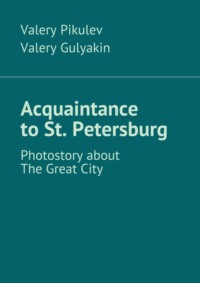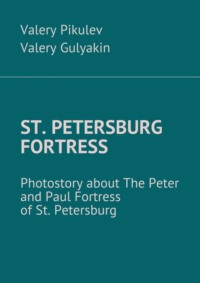
Полная версия
Water and Stone. Historical story

On a background – a dome of the Tatar mosque. View from the bridge, from outside left coast of Neva. (The bridge – at the left, off-screen)

Right coast

Right coast of Neva (views from The Trinity Bridge)
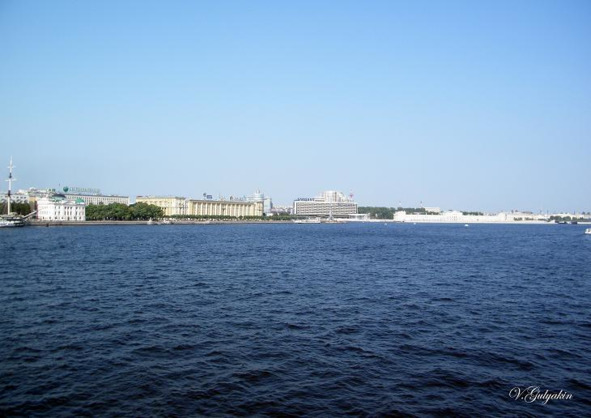
Panorama of The Petrograd Side (the same right coast of Neva, to the right of the bridge)

To the left of The Trinity Bridge the strip of greens of The Summer garden is seen (it is already left coast of Neva)
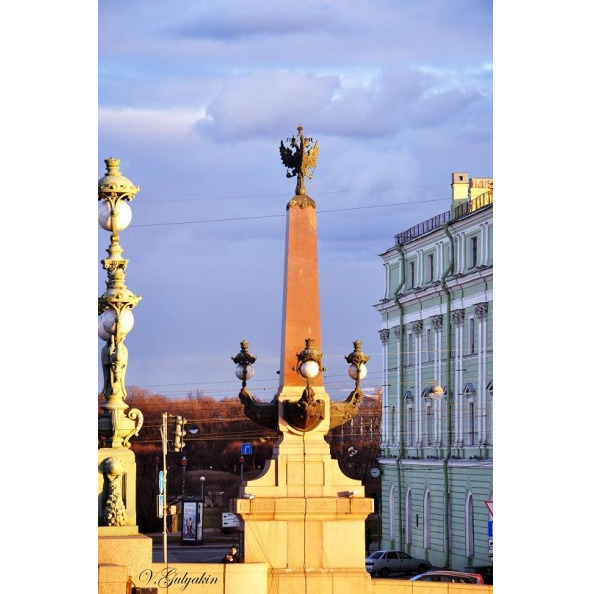
The Trinity Bridge. Left coast of Neva

Fencing of The Summer garden well-known for the whole world

On a background – a left bank of Neva

Protected at the left, protected on the right…

Winter Palace, St. Isaac’s Cathedral and Admiralty…

Even closer…

Panorama of The Winter Palace, Admiralty and Spit of Vasilyevsky Island

Here it, Spit of Vasilyevsky Island well-known for the whole world

The Saint Petersburg Stock Exchange building

Also we were turned back into place. And again Peter and Paul Fortress. Evening falls by St. Petersburg
So, the first acquaintance, with St. Petersburg took place. And now, dear readers if you had a desire to learn about this Great City more, we will go further.
Having surveyed the historic center of St. Petersburg from Trinity Bridge, “right on the spot” – and most of guests arrives in our city, as a rule, from the South (from Moscow), and it is simple to them not to bypass this bridge, – now “from the place to descend”, to us, nevertheless, it is necessary: we pass from “nodding” acquaintance to The Great City to deeper which for the majority, it is sure, will turn into great friendship. So, we will descend from Trinity Bridge and we will go there from where the city “eats-went”.
And so far we will look once more at our handsome, – at The Trinity Bridge.

The Trinity Bridge. View from the right coast of Neva

…Like the good old days!
It is a little history
Rainy October, 1702. Troops of the associate and the friend Peter I, the general field marshal Boris Sheremetev take storm the Swedish fortress Noteburg. Peter participates in this nice business! No, not in the Commander-in-chief rank – save, God! – and only goal-scorer captain: he has no need “to be stuck out”, he and so – Peter The Great! This fortress, having a reputation for unapproachable hitherto, costs on the island in the mouth of the Neva River and, together with other fortress, – Nienschanz, – that is lower on a current, controls, and, speaking simply, – tightly bars for Russians all waterway from Lake Ladoga to the Baltic Sea. In half a year, at the beginning of May, 1703, the Nienschanz is given. Without fight.
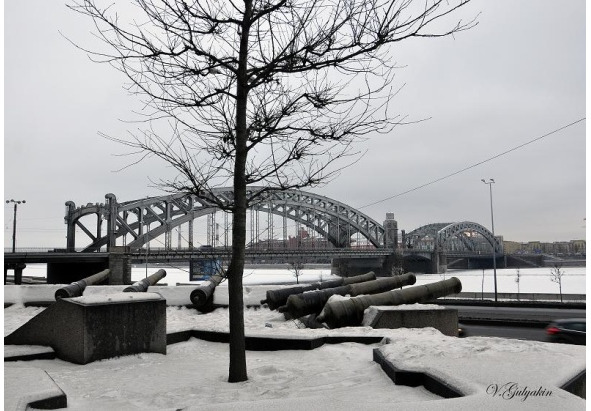
Symbolical reconstruction of fortress Nienschanz
Well, on the lands which are just won from the Swede, on this major water communication, it is necessary to be fixed. Prompt in the rushes Peter makes the fast decision! And here, on May 16, 1703 – remember this blessed date (in old style)! – marshy coast of the Nevsky delta are disclosed by amicable knock of axes and squeal of saws: the forced construction of fortress began. – And, of course, on the island, that around water! The island is this, known to Swedes as Lust-Eland (“cheerful”), and to Finns – Enisaari, by Russians it was nicknamed Hare. But, about it a bit later…
Generally, St. Petersburg is located more than on 30 islands (and to these nobody found time to bring full clarity in this question: some bring their number to the 42nd if to consider also artificial). In the city 342 bridges (and together with suburban, there are a lot of more than five hundred: call even number 580). Five hundred bridges which hung over nearly fifty rivers, channels, small rivers and channels – than not Venice!
Let’s return, however, that May day. “In the 16th day of May (in a week of Pentecost) fortress is put and called Sanktpiterburkh” – so about this event the tsar Peter will write! This date – on May 16 (on May 27 on new style) 1703 – is also the Birthday of St. Petersburg!
Dear reader, at you can arise a reasonable question: and why, actually, on May 27, but not the 29th … – upon transition from the Julian calendar, – by the way, one of Peter’s reforms to which time in Russia was considered not since Christmas, and… from creation of the world! – and so, upon transition from the Julian calendar to Gregorian on which there lives the whole Europe it would be necessary to add 13 days, but not 11. And it is absolutely fair … – for start date of the twentieth century. To dates of the nineteenth century agreed to add only 12 days; for the 18th – already 11. And for all other centuries leaving deep into stories add 13 days, again “not to take a steam bath”. There is such piece!
The small island on which put fortress is separated from the neighboring huge island rather narrow, but quite fast by a channel. From this blessed island, all also began with it. There, on this small island, we will also go.

Type of The St. Petersburg (Peter and Paul) fortress from a channel. Big Neva – at the left (off-screen)

And so “Peter and Paul Fortress” at a descent from Trinity Bridge looks
“Storm” of The St. Petersburg Fortress
Well, we start “storm” of the Peter and Paul Fortress … – quite so we, Petersburgers, in a familiar way we call Peter and Paul and if absolutely officially, – St. Petersburg – fortress. Before starting this no laughing matter, – detailed acquaintance to fortress, – investigating all its back streets and being inspired by genius of architectural concepts, we will approach at first Ioannovsky Bridge, to very first of the St. Petersburg bridges. However, in those far times it was called Petrovsky…

Ioannovsky Bridge through the Kronverksky passage (through that to a channel)
On one of pile ice-cutting blocks before the bridge the figure of “the hare who escaped from a flood” established here to the 300 anniversary of the city is well distinguishable. On one of legends, during a flood the hare found rescue, having jumped on a boot to the tsar Peter… Here, tourists “for luck” also throw coins, trying to get a hare directly into a pan!
Ioannovsky Bridge – one of two ways conducting in The Peter and Paul Fortress.

One more symbol of the city: the hare who escaped from a flood
The bridge is thrown through the Kronverksky passage and connects the Hare island on which The Peter and Paul Fortress is located, to the Petrograd island where we now also are, having descended on it from Trinity Bridge.
Petrovsky Bridge, namely so it was called in the beginning, arose at the same time with construction of The St. Petersburg fortress, was adjustable and leaned on wooden barques. Then, in 1706, instead of the floating bridge appeared lifting, already on the wooden piles replaced subsequently with stone foundations. Since 1887 began to be called Ioannovsky – according to the name of one of fortress ravelins.
A little more than 150 meters long and 10 meters wide, the bridge does not suppress the sizes, but its wooden flooring which is boomingly “giving” steps, a decor of a protective lattice with “semi-antique” lamps… Yes, link of times is felt here – mighty well!

Lamps and fragments of a decor of a protective lattice of Ioannovsky Bridge

Yes, link of times is felt here…
Footpath, to the left of the bridge, winding along external walls of fortress, conducts directly to the city beach, and the path which is running away to the right – to the helipad from where it is possible to make flight over the city.

We get into the helicopter…

…Also we fly
No, we will not depart, and we will go directly, anywhere without turning, – in fortress. And here, we go on a wooden flooring of Ioannovsky Bridge, listening attentively to boomingly given steps, and we go to gate of the Ioannovsky ravelin. Their cool twilight as if foretells a meeting with history…
Nevertheless, why for Peter this fortress, never, besides, not being involved in battles was necessary? What forced him which just took two terrible fortresses at Swedes – Noteburg and Nienschanz, – to urgently build one more? Besides, the Nienschanz located in the median Neva Current as well as possible corresponded to a role of customs “latch” for collection of duty from all who will carry down the river to Russia goods. And militarily fortress could serve still, covering future city from the West, be built it under protection of its walls. And Noteburg, – fire of its serf artillery would stop any who will dare to threaten the city from the East. But, probably, in that there was also Peter’s idea, – “we will threaten the Swede from here!” – that it was also not going to defend, he looked further!
Peter needed the fleet. Only the military fleet could make Russia the great sea power – “a leg firm to become at the sea”! But whether the fleet which construction only still began could, and crews of the ships are untrained, – whether such fleet could resist to skilled Swedes in the high sea? And where to cover the ships having big draft from the perfidious opponent, – not in narrow bends of the river?! – No, the Nienschanz for this purpose was no good at all! – The big water area, broad river lands is necessary. At the Gulf!
And here, if to construct fortress on the island, in the delta of Neva, – in that place where the river, being divided into two deep sleeves, forms the widest smooth surface of quiet water, – here then pass from the sea will be closed reliably!
“For several days the convenient place is found to that…” – Peter in the diary will write down. The island on which it decided to build fortress from three parties is washed by waters of wide Neva, and from the neighboring big island it is separated quite fast a channel, representing a natural defensive barrier. Here on this island the first stone of the city of Saint Apostle Peter was also put… and there was it, as we know, in the 1703rd year A.D., May, the 16th day…
Конец ознакомительного фрагмента.
Текст предоставлен ООО «ЛитРес».
Прочитайте эту книгу целиком, купив полную легальную версию на ЛитРес.
Безопасно оплатить книгу можно банковской картой Visa, MasterCard, Maestro, со счета мобильного телефона, с платежного терминала, в салоне МТС или Связной, через PayPal, WebMoney, Яндекс.Деньги, QIWI Кошелек, бонусными картами или другим удобным Вам способом.




